AlGaN/GaN MIS-HEMT with PECVD SiNx, SiON, SiO2 as Gate Dielectric and Passivation Layer
Abstract
:1. Introduction
2. Materials and Methods
3. Results and Discussion
4. Conclusions
Author Contributions
Funding
Conflicts of Interest
References
- Chen, K.J.; Haberlen, O.; Lidow, A.; Tsai, C.L.; Ueda, T.; Uemoto, Y.; Wu, Y. GaN-on-Si Power Technology: Devices and Applications. IEEE Trans. Electron. Dev. 2017, 64, 779–795. [Google Scholar] [CrossRef]
- Lee, J.; Kim, H.; Seo, K.; Cho, C.; Cha, H. High quality PECVD SiO2 process for recessed MOS-gate of AlGaN/GaN-on-Si metal–oxide–semiconductor heterostructure field-effect transistors. Solid State Electron. 2016, 122, 32–36. [Google Scholar] [CrossRef]
- Chakroun, A.; Jaouad, A.; Soltani, A.; Arenas, O.; Aimez, V.; Ares, R.; Maher, H. AlGaN/GaN MOS-HEMT Device Fabricated Using a High Quality PECVD Passivation Process. IEEE Electr. Device Lett. 2017, 38, 779–782. [Google Scholar] [CrossRef]
- Kordoš, P.; Heidelberger, G.; Bernát, J.; Fox, A.; Marso, M.; Lüth, H. High-power SiO2/AlGaN/GaN metal-oxide-semiconductor heterostructure field-effect transistors. Appl. Phys. Lett. 2005, 87, 143501. [Google Scholar] [CrossRef]
- Arulkumaran, S.; Egawa, T.; Ishikawa, H. Studies of Electron Beam Evaporated SiO2/AlGaN/GaN Metal—Oxide—Semiconductor High-Electron-Mobility Transistors. Jpn. J. Appl. Phys. 2005, 44. [Google Scholar] [CrossRef]
- Chiou, Y. Photo-CVD SiO2 Layers on AlGaN/GaN/AlGaN MOS-HFETs. J. Electrochem. Soc. 2004, 151, G863–G865. [Google Scholar] [CrossRef]
- Jiang, H.; Liu, C.; Chen, Y.; Lu, X.; Tang, C.W.; Lau, K.M. Investigation of Insitu SiN as Gate Dielectric and Surface Passivation for GaN MISHEMTs. IEEE Trans. Electron. Dev. 2017, 64, 832–839. [Google Scholar] [CrossRef]
- Tang, Z.; Jiang, Q.; Lu, Y.; Huang, S.; Yang, S.; Tang, X.; Chen, K.J. 600-V Normally Off SiNx/AlGaN/GaN MIS-HEMT With Large Gate Swing and Low Current Collapse. IEEE Electr Device Lett. 2013, 34, 1373–1375. [Google Scholar] [CrossRef]
- Zhang, Z.; Yu, G.; Zhang, X.; Deng, X.; Li, S.; Fan, Y.; Sun, S.; Song, L.; Tan, S.; Wu, D.; et al. Studies on High-Voltage GaN-on-Si MIS-HEMTs Using LPCVD Si3N4 as Gate Dielectric and Passivation Layer. IEEE Trans. Electron. Dev. 2016, 63, 731–738. [Google Scholar] [CrossRef]
- Arulkumaran, S.; Hong, L.Z.; Ing, N.G.; Selvaraj, S.L.; Egawa, T. Influence of Ammonia in the Deposition Process of SiN on the Performance of SiN/AlGaN/GaN Metal–Insulator–Semiconductor High-Electron-Mobility Transistors on 4-in. Si(111). Appl. Phys. Express 2009, 2, 31001. [Google Scholar] [CrossRef]
- Adivarahan, V.; Gaevski, M.; Sun, W.H.; Fatima, H.; Koudymov, A.; Saygi, S.; Simin, G.; Yang, J.; Khan, M.A.; Tarakji, A.; et al. Submicron gate Si3N4/AlGaN/GaN-metal-insulator-semiconductor heterostructure field-effect transistors. IEEE Electr. Device Lett. 2003, 24, 541–543. [Google Scholar] [CrossRef]
- Kim, H.; Han, S.; Jang, W.; Cho, C.; Seo, K.; Oh, J.; Cha, H. Normally-Off GaN-on-Si MISFET Using PECVD SiON Gate Dielectric. IEEE Electr. Device Lett. 2017, 38, 1090–1093. [Google Scholar] [CrossRef]
- Balachander, K.; Arulkumaran, S.; Egawa, T.; Sano, Y.; Baskar, K. A comparison on the Electrical Characteristics of SiO2, SiON and SiN as the Gate Insulators for the Fabrication of AlGaN/GaN Metal–Oxide/Insulator–Semiconductor High-Electron Mobility-Transistors. Jpn. J. Appl. Phys. 2005, 44, 4911–4913. [Google Scholar] [CrossRef]
- Balachander, K.; Arulkumaran, S.; Egawa, T.; Sano, Y.; Baskar, K. Demonstration of AlGaN/GaN metal-oxide-semiconductor high-electron-mobility transistors with silicon-oxy-nitride as the gate insulator. Mater. Sci. Eng. B 2005, 119, 36–40. [Google Scholar] [CrossRef]
- Balachander, K.; Arulkumaran, S.; Ishikawa, H.; Baskar, K.; Egawa, T. Studies on electron beam evaporated ZrO2/AlGaN/GaN metal-oxide-semiconductor high-electron-mobility transistors. Phys. Status Solidi A 2005, 202, R16–R18. [Google Scholar] [CrossRef]
- Ye, P.D.; Yang, B.; Ng, K.K.; Bude, J.; Wilk, G.D.; Halder, S.; Hwang, J.C.M. GaN metal-oxide-semiconductor high-electron-mobility-transistor with atomic layer deposited Al2O3 as gate dielectric. Appl. Phys. Lett. 2005, 86, 63501. [Google Scholar] [CrossRef]
- Liu, Z.H.; Ng, G.I.; Arulkumaran, S.; Maung, Y.K.T.; Teo, K.L.; Foo, S.C.; Sahmuganathan, V.; Xu, T.; Lee, C.H. High Microwave-Noise Performance of AlGaN/GaN MISHEMTs on Silicon with Al2O3 Gate Insulator Grown by ALD. IEEE Electr. Device Lett. 2010, 31, 96–98. [Google Scholar]
- Asif, M.; Chen, C.; Peng, D.; Xi, W.; Zhi, J. Improved DC and RF performance of InAlAs/InGaAs InP based HEMTs using ultra-thin 15 nm ALD-Al2O3 surface passivation. Solid State Electron. 2018, 142, 36–40. [Google Scholar] [CrossRef]
- Liu, C.; Chor, E.F.; Tan, L.S. Investigations of HfO2/AlGaN/GaN metal-oxide-semiconductor high electron mobility transistors. Appl. Phys. Lett. 2006, 88, 173504. [Google Scholar] [CrossRef]
- Anand, M.J.; Ng, G.I.; Vicknesh, S.; Arulkumaran, S.; Ranjan, K. Reduction of current collapse in AlGaN/GaN MISHEMT with bilayer SiN/Al2O3 dielectric gate stack. Phys. Status Solidi C 2013, 10, 1421–1425. [Google Scholar] [CrossRef]
- Balachander, K.; Arulkumaran, S.; Sano, Y.; Egawa, T.; Baskar, K. Fabrication of AlGaN/GaN double-insulator metal-oxide-semiconductor high-electron-mobility transistors using SiO2 and SiN as gate insulators. Phys. Status Solidi A 2005, 202, R32–R34. [Google Scholar] [CrossRef]
- Miyazaki, E.; Goda, Y.; Kishimoto, S.; Mizutani, T. Comparative study of AlGaN/GaN metal-oxide-semiconductor heterostructure field-effect transistors with Al2O3 and HfO2 gate oxide. Solid State Electron. 2011, 62, 152–155. [Google Scholar] [CrossRef]
- Chang, Y.C.; Huang, M.L.; Chang, Y.H.; Lee, Y.J.; Chiu, H.C.; Kwo, J.; Hong, M. Atomic-layer-deposited Al2O3 and HfO2 on GaN: A comparative study on interfaces and electrical characteristics. Microelectron. Eng. 2011, 88, 1207–1210. [Google Scholar] [CrossRef]
- Green, B.M.; Chu, K.K.; Chumbes, E.M.; Smart, J.A.; Shealy, J.R.; Eastman, L.F. The effect of surface passivation on the microwave characteristics of undoped AlGaN/GaN HEMTs. IEEE Electr. Device Lett. 2000, 21, 268–270. [Google Scholar] [CrossRef]
- Meneghesso, G.; Verzellesi, G.; Danesin, F.; Rampazzo, F.; Zanon, F.; Tazzoli, A.; Meneghini, M.; Zanoni, E. Reliability of GaN High-Electron-Mobility Transistors: State of the Art and Perspectives. IEEE Trans. Device Mater. Reliab. 2008, 8, 332–343. [Google Scholar] [CrossRef]
- Arulkumaran, S.; Ng, G.I.; Liu, Z.H. Effect of gate-source and gate-drain Si3N4 passivation on current collapse in AlGaN/GaN high-electron-mobility transistors on silicon. Appl. Phys. Lett. 2007, 90, 173504. [Google Scholar] [CrossRef]
- Arulkumaran, S.; Egawa, T.; Ishikawa, H.; Jimbo, T.; Sano, Y. Surface passivation effects on AlGaN/GaN high-electron-mobility transistors with SiO2, Si3N4, and silicon oxynitride. Appl. Phys. Lett. 2004, 84, 613–615. [Google Scholar] [CrossRef]
- Javorka, P.; Bernat, J.; Fox, A.; Marso, M.; Lüth, H.; Kordoš, P. Influence of SiO2 and Si3N4 passivation on AIGaN/GaN/Si HEMT performance. Electron. Lett. 2003, 39, 1155–1157. [Google Scholar] [CrossRef]
- Lu, X.; Yu, K.; Jiang, H.; Zhang, A.; Lau, K.M. Study of Interface Traps in AlGaN/GaN MISHEMTs Using LPCVD SiNx as Gate Dielectric. IEEE Trans. Electron. Dev. 2017, 64, 824–831. [Google Scholar] [CrossRef]
- Mizue, C.; Hori, Y.; Miczek, M.; Hashizume, T. Capacitance-Voltage Characteristics of Al2O3/AlGaN/GaN Structures and State Density Distribution at Al2O3/AlGaN Interface. Jpn. J. Appl. Phys. 2011, 50. [Google Scholar] [CrossRef]
- Capriotti, M.; Alexewicz, A.; Fleury, C.; Gavagnin, M.; Bethge, O.; Visalli, D.; Derluyn, J.; Wanzenböck, H.D.; Bertagnolli, E.; Pogany, D.; et al. Fixed interface charges between AlGaN barrier and gate stack composed of insitu grown SiN and Al2O3 in AlGaN/GaN high electron mobility transistors with normally off capability. Appl. Phys. Lett. 2014, 104, 113502. [Google Scholar] [CrossRef]
- Hung, T.; Krishnamoorthy, S.; Esposto, M.; Neelim Nath, D.; Sung Park, P.; Rajan, S. Interface charge engineering at atomic layer deposited dielectric/III-nitride interfaces. Appl. Phys. Lett. 2013, 102, 72105. [Google Scholar] [CrossRef]
- Zhu, J.; Ma, X.; Xie, Y.; Hou, B.; Chen, W.; Zhang, J.; Hao, Y. Improved Interface and Transport Properties of AlGaN/GaN MIS-HEMTs with PEALD-Grown AlN Gate Dielectric. IEEE Trans. Electron. Dev. 2015, 62, 512–518. [Google Scholar]
- Son, J.; Chobpattana, V.; McSkimming, B.M.; Stemmer, S. Fixed charge in high-k/GaN metal-oxide-semiconductor capacitor structures. Appl. Phys. Lett. 2012, 101, 102905. [Google Scholar] [CrossRef] [Green Version]
- Liu, S.; Huang, C.; Chang, C.; Lin, Y.; Chen, B.; Tsai, S.; Majlis, B.Y.; Dee, C.; Chang, E.Y. Effective Passivation with High-Density Positive Fixed Charges for GaN MIS-HEMTs. IEEE J. Electron. Dev. 2017, 5, 170–174. [Google Scholar] [CrossRef]
- Yang, S.; Liu, S.; Lu, Y.; Liu, C.; Chen, K.J. AC-Capacitance Techniques for Interface Trap Analysis in GaN-Based Buried-Channel MIS-HEMTs. IEEE Trans. Electron Dev. 2015, 62, 1870–1878. [Google Scholar] [CrossRef]
- Zhang, D.; Cheng, X.; Zheng, L.; Shen, L.; Wang, Q.; Gu, Z.; Qian, R.; Wu, D.; Zhou, W.; Cao, D.; et al. Effects of polycrystalline AlN film on the dynamic performance of AlGaN/GaN high electron mobility transistors. Mater. Des. 2018, 148, 1–7. [Google Scholar] [CrossRef]
- Reshchikov, M.A.; Morkoç, H. Luminescence properties of defects in GaN. J. Appl. Phys. 2005, 97, 61301. [Google Scholar] [CrossRef]
- Kaufmann, U.; Kunzer, M.; Obloh, H.; Maier, M.; Manz, C. Origin of defect-related photoluminescence bands in doped and nominally undoped GaN. Phys. Rev. B Condens. Matter 1999, 59, 5561. [Google Scholar] [CrossRef]
- Chevtchenko, S.A.; Reshchikov, M.A.; Fan, Q.; Ni, X.; Moon, Y.T.; Baski, A.A.; Morkoç, H. Study of SiNx and SiO2 passivation of GaN surfaces. J. Appl. Phys. 2007, 101, 1139–1190. [Google Scholar] [CrossRef]
- Hashizume, T.; Hasegawa, H. Effects of nitrogen deficiency on electronic properties of AlGaN surfaces subjected to thermal and plasma processes. Appl. Surf. Sci. 2004, 234, 387–394. [Google Scholar] [CrossRef] [Green Version]
- Eller, B.S.; Yang, J.; Nemanich, R.J. Electronic surface and dielectric interface states on GaN and AlGaN. J. Vacuum Sci. Technol. A Vacuum Surf. Films 2013, 31, 50807. [Google Scholar] [CrossRef]
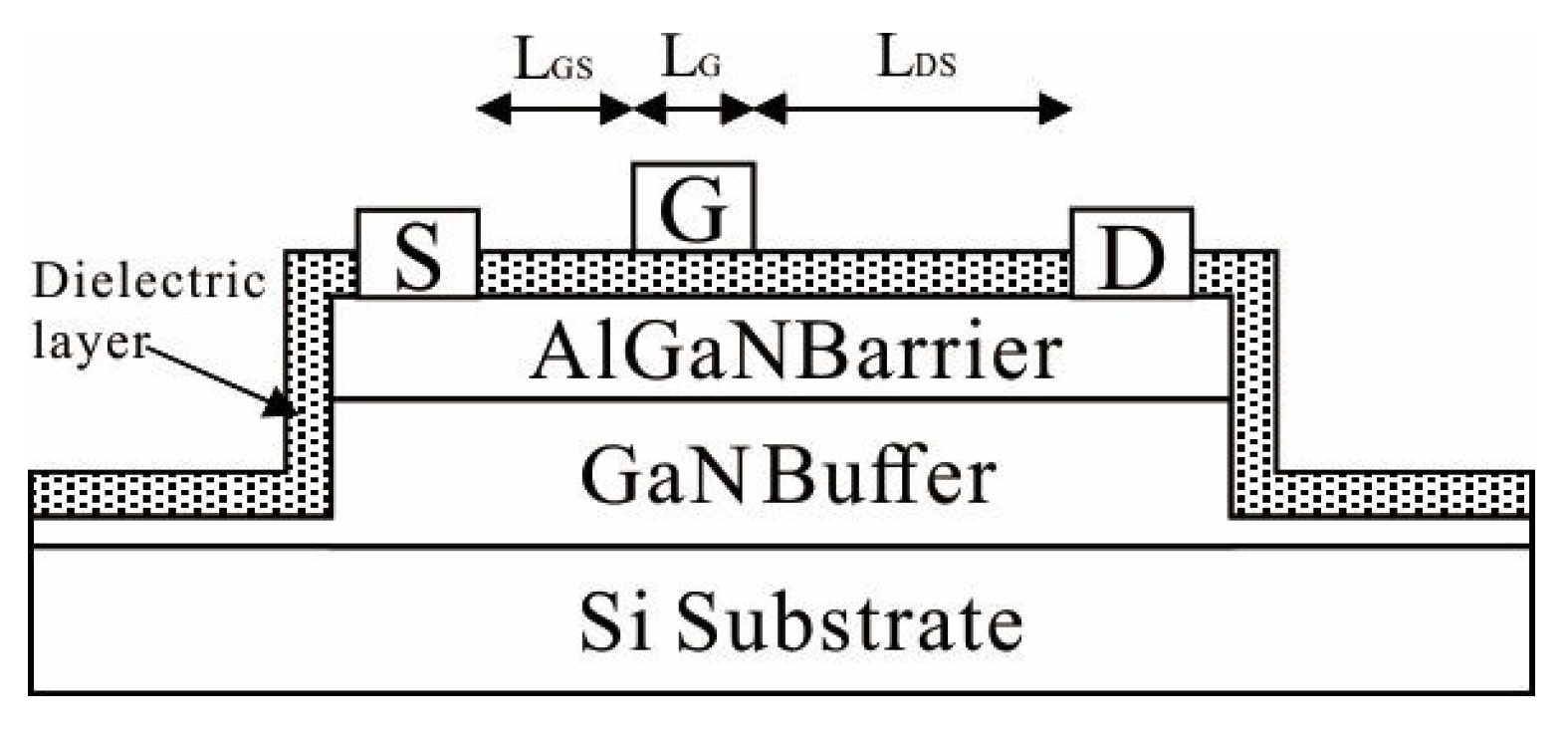
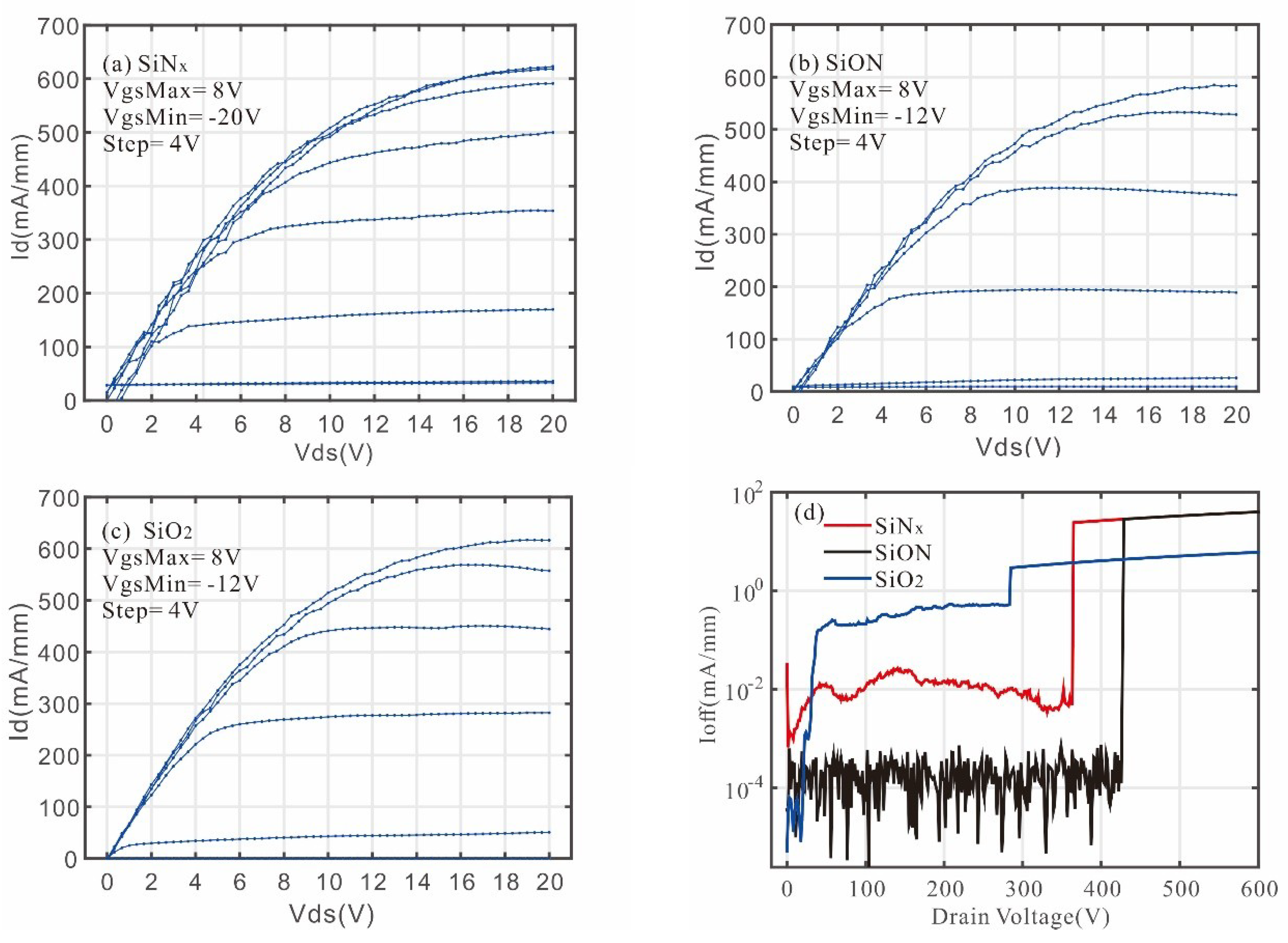
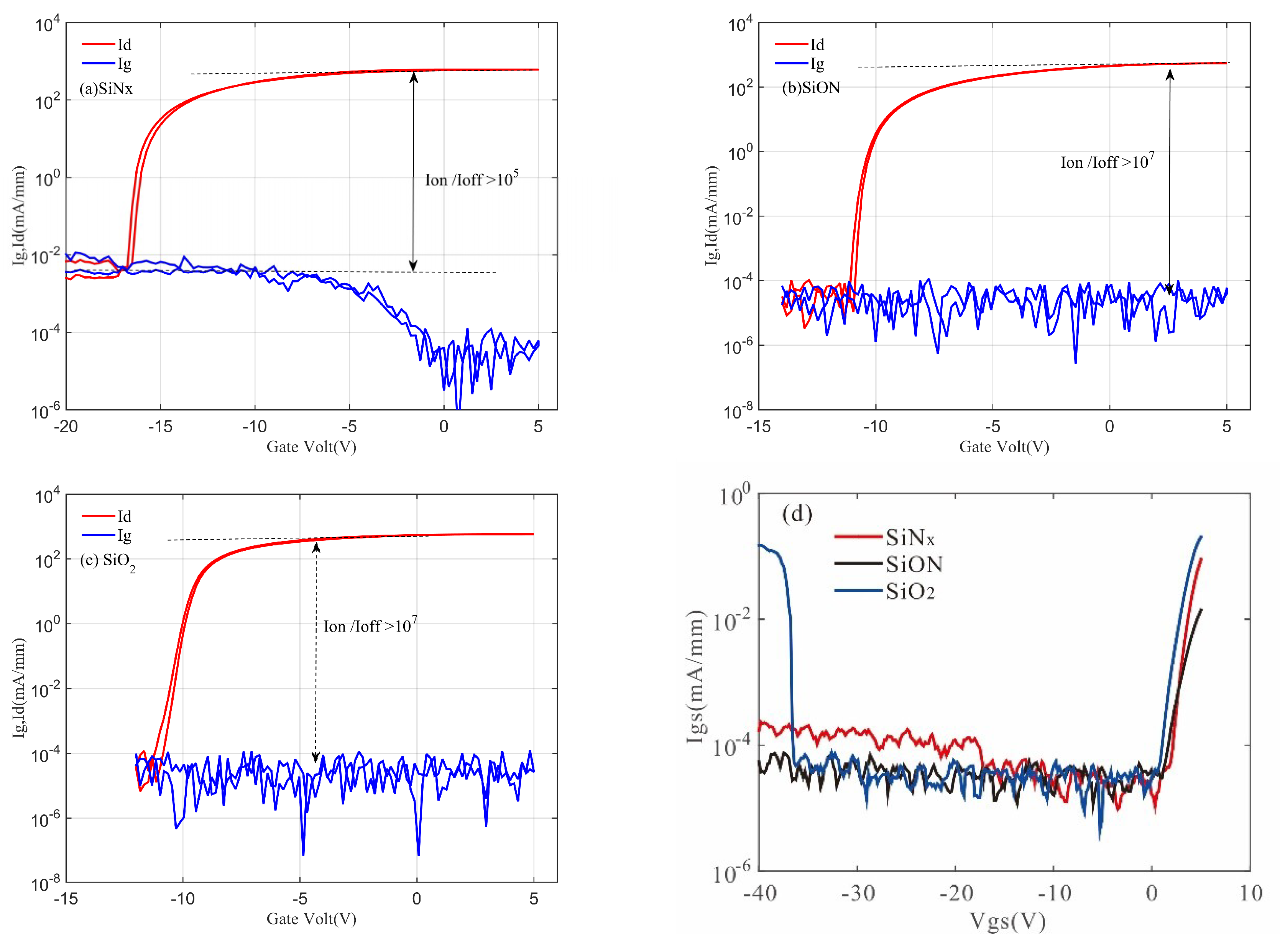
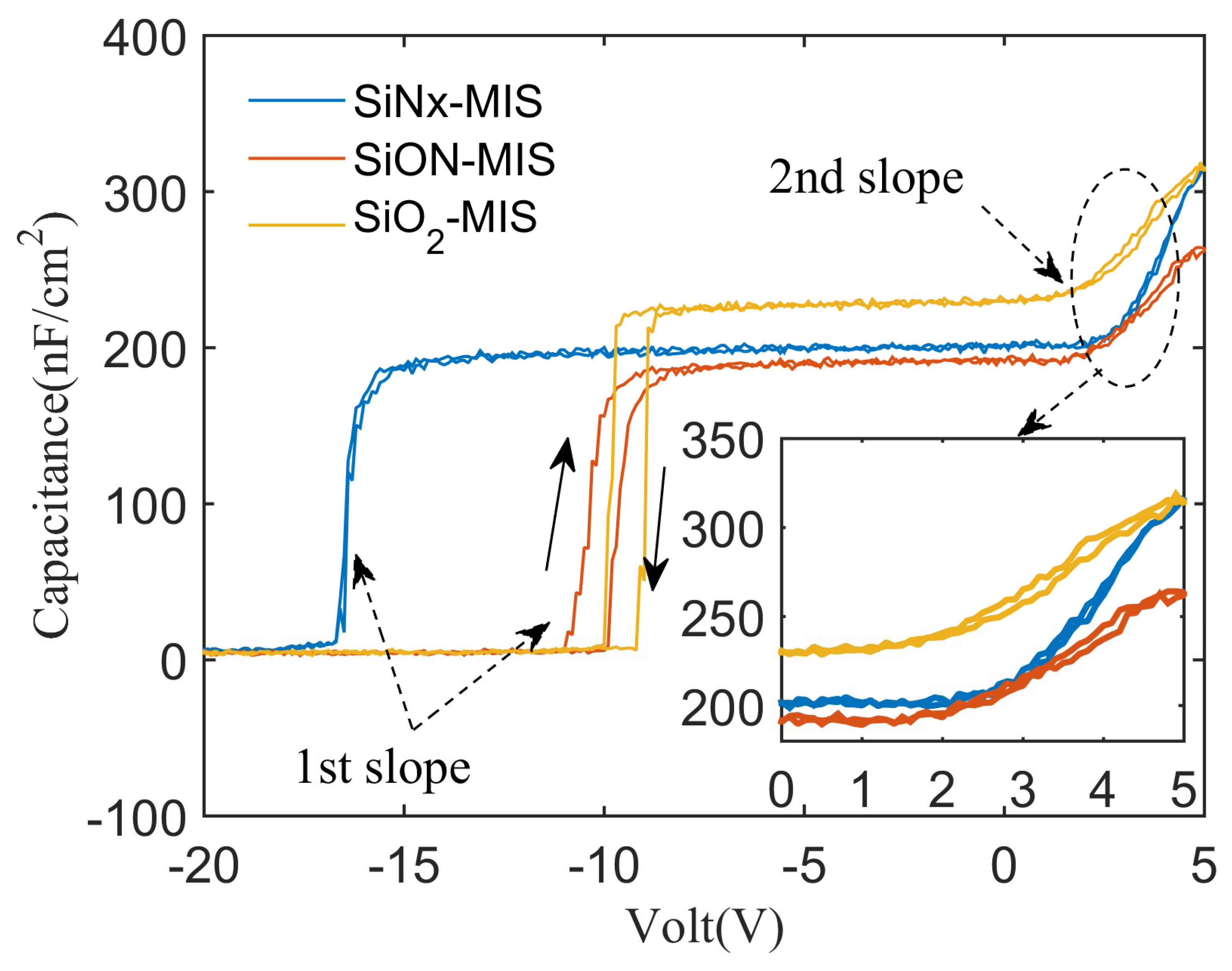
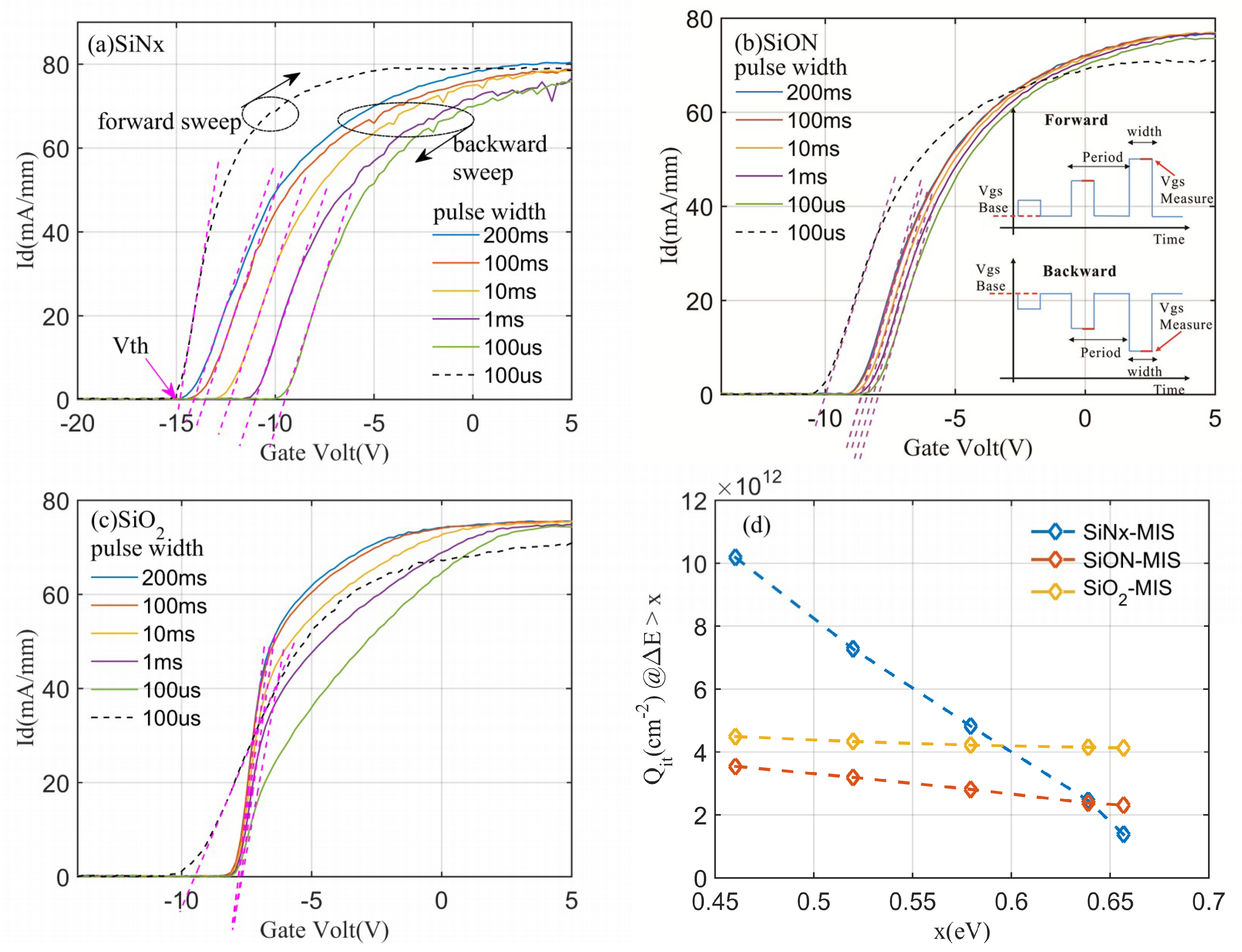
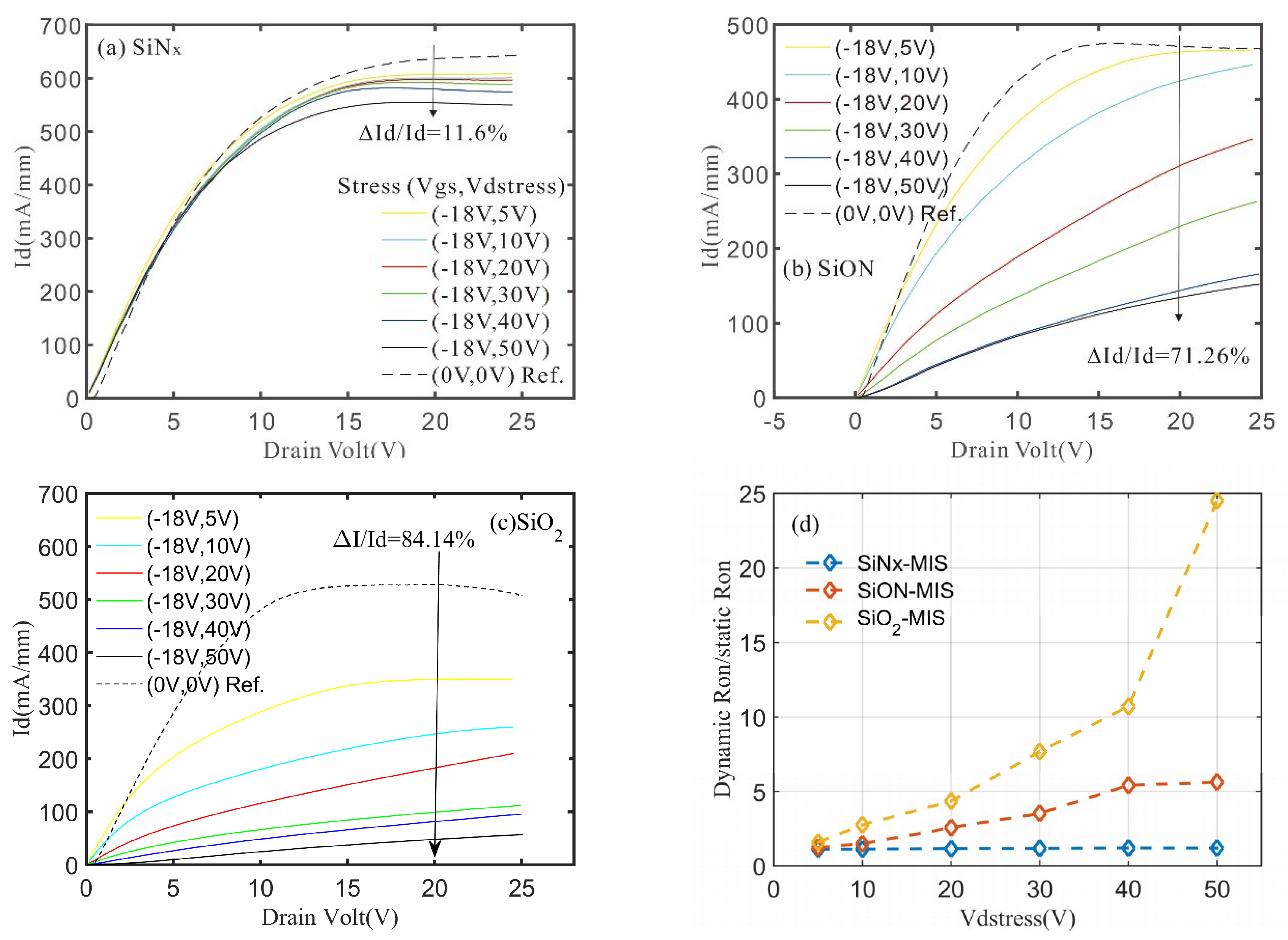

| Sample | Pressure (millitorr) | RF Power(W) | SiH4 1 (sccm2) | N2O (sccm) | NH3 (sccm) | TEM (°C) | Refractive Index 3 |
|---|---|---|---|---|---|---|---|
| SiNx | 650 | 50 | 150 | 0 | 25 | 300 | 1.82 |
| SiON | 500 | 75 | 25 | 20 | 40 | 300 | 1.56 |
| SiO2 | 650 | 50 | 100 | 1000 | 0 | 300 | 1.46 |
| Sample | Idmax (mA/mm) | gmmax (mS/mm) | Vth | Gate Leakage 1 (mA/mm) | Off-State Breakdown Voltage (V) | %I 2 | Dynamic Ron/Static Ron 3 |
|---|---|---|---|---|---|---|---|
| SiNx | 623 | 62.7 | −16.7 | 4.46 E-4 | 364 | 11.6% | 1.18 |
| SiON | 590 | 55.3 | −11.7 | 3.86 E-5 | 428 | 71.26% | 5.64 |
| SiO2 | 620 | 81.3 | −9.9 | 3.12 E-5 | 284 | 84.14% | 24.5 |
© 2018 by the authors. Licensee MDPI, Basel, Switzerland. This article is an open access article distributed under the terms and conditions of the Creative Commons Attribution (CC BY) license (http://creativecommons.org/licenses/by/4.0/).
Share and Cite
Geng, K.; Chen, D.; Zhou, Q.; Wang, H. AlGaN/GaN MIS-HEMT with PECVD SiNx, SiON, SiO2 as Gate Dielectric and Passivation Layer. Electronics 2018, 7, 416. https://doi.org/10.3390/electronics7120416
Geng K, Chen D, Zhou Q, Wang H. AlGaN/GaN MIS-HEMT with PECVD SiNx, SiON, SiO2 as Gate Dielectric and Passivation Layer. Electronics. 2018; 7(12):416. https://doi.org/10.3390/electronics7120416
Chicago/Turabian StyleGeng, Kuiwei, Ditao Chen, Quanbin Zhou, and Hong Wang. 2018. "AlGaN/GaN MIS-HEMT with PECVD SiNx, SiON, SiO2 as Gate Dielectric and Passivation Layer" Electronics 7, no. 12: 416. https://doi.org/10.3390/electronics7120416





